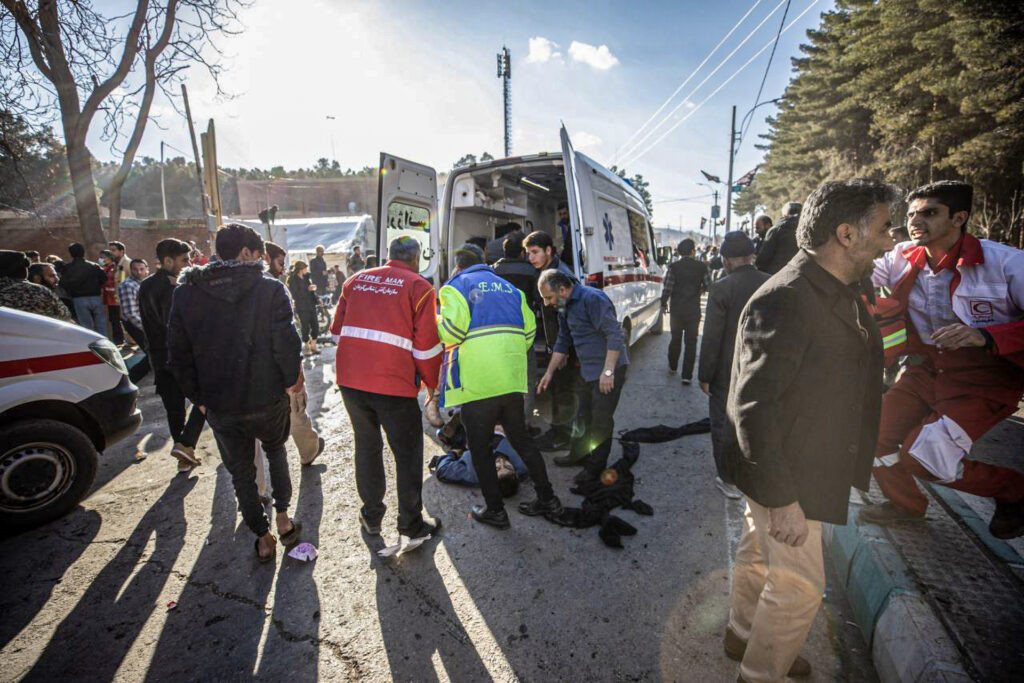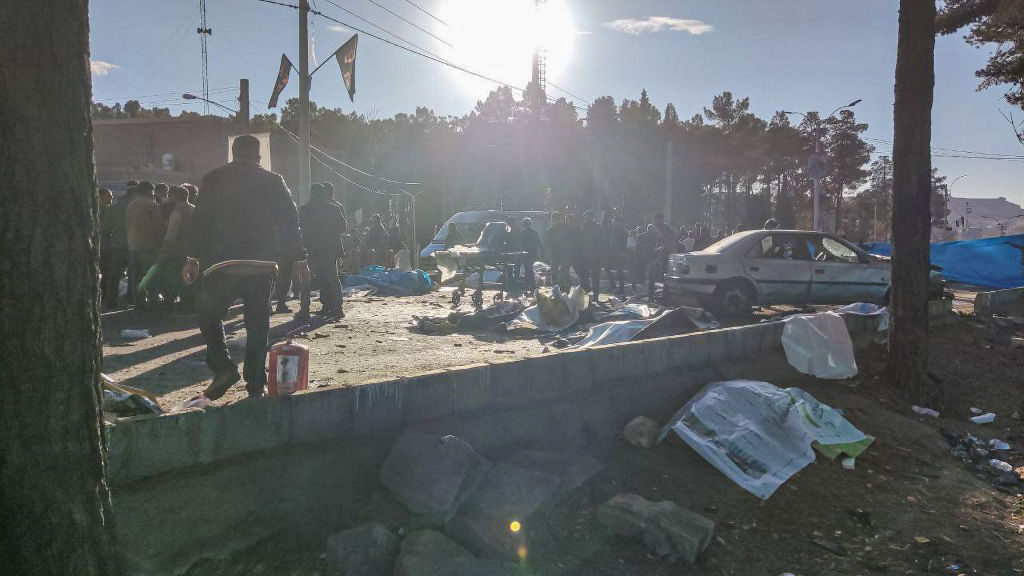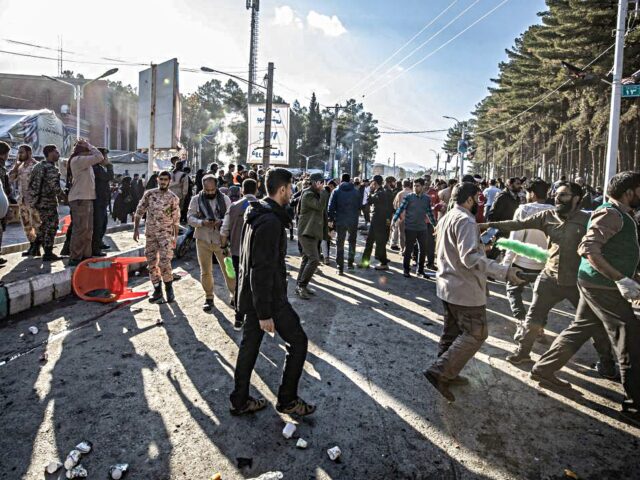Multiple Iranian state-affiliated news outlets reported the deaths on Wednesday of between 20 and 73 people at a parade honoring late terrorist Qasem Soleimani near his tomb in southern Kerman, the result of what investigations are initially describing as “twin” explosions detonated by remote.
Update: Since the time of publication of this article, Iranian authorities have updated the casualty count to 103 people killed and 141 wounded, including some in critical condition.
The IRGC-affiliated Tasnim News Agency reported on Wednesday that two explosions rocked the event “as people were packed on a road leading to a cemetery where the tomb of General Soleimani is located,” 13 minutes apart. Terrorists often use multiple explosions to target both their initial victims and first responders deploying to save those injured.
“Sources told a Tasnim reporter in Kerman that the perpetrator or perpetrators of the attack have exploded two explosive-laden suitcases with remote controllers,” the outlet asserted, describing the explosions as terrorism.
Prior reports suggested the possibility of an accidental gas cylinder explosion, though local officials later began openly declaring the explosions intentional.

An infographic shows where the explosion at Qasem Soleimani’s tomb took place. (Yasin Demirci/Anadolu via Getty Images)
Tasnim reported that those maimed in the explosions were both hurt by the blasts and “injured in a stampede in a state of panic.”
Tasnim described the death toll as being in the “dozens.” Iran International, an anti-regime outlet, citing other state news reports estimated that 20 people had died in the explosions and at least another 15 injured.
The Israeli news organization i24 reported that “at least 50” were killed in the event.
Iranian emergency services official Babak Yektaparast reportedly appeared on state television later on Wednesday and announced the regime had confirmed the deaths of 73 people and another 170 injured.
Footage from the event indicated that the Iranian regime had mobilized thousands of people to crowd into the city and march to the cemetery, an attempt to rehabilitate Soleimani’s image in life as a mass murderer into that of a beloved patriot.
Soleimani served as the head of the Quds Force, the foreign terror arm of the Islamic Revolutionary Guard Corps (IRGC), until January 3, 2020, when former President Donald Trump approved an airstrike in Iraq to eliminate him and the head of the Iranian-back militia the Hezbollah Brigades, Abu Mahdi al-Muhandis. The IRGC is a formal arm of the Iranian armed forces and a U.S.-designated terrorist organization.
The Quds Force helps Iran extend its jihadist influence in neighboring countries – such as Iraq, Syria, and Yemen – and in allied nations such as Venezuela and Cuba.
Soleimani was believed to be in charge of relations between Iran and groups like the Hezbollah Brigades but also a key shadow diplomat in contact with the socialist regime of Nicolás Maduro in Venezuela, occasionally clashing with Iran’s legitimate diplomats. He was also considered indispensable in Iran’s involvement in the Syrian Civil War on behalf of dictator Bashar al-Assad, who ultimately won the war with Iranian and Russian support.
“His death is a huge loss for Iran’s regime and its Iraqi proxies, and a major operational and psychological victory for the United States,” Lt. Col. (Ret.) James Carafano, vice president of the Heritage Foundation’s Davis Institute for National Security and Foreign Policy, said of Soleimani in 2020.

A view of the scene after explosions leaving at least 73 feared dead in explosions near slain Gen. Qasem Soleimani’s tomb, in Kerman City, Iran on January 03, 2024. (Photo by Stringer/Anadolu via Getty Images)

A view of the scene after explosions leaving at least 73 feared dead in explosions near slain Gen. Qasem Soleimani’s tomb, in Kerman City, Iran on January 03, 2024. (Stringer/Anadolu via Getty Images)
“Soleimani was the Iranian Regime’s most ruthless butcher, a monster who murdered or wounded thousands of American service members in Iraq,” President Donald Trump said during his 2020 State of the Union address. “As the world’s top terrorist, Soleimani orchestrated the deaths of countless men, women, and children. He directed the December assault on United States Forces in Iraq, and was actively planning new attacks.”
The Iranian regime ultimately replaced Soleimani with Esmail Qaani, a more low-profile terrorist with a significant role in Iran’s involvement in Syria.
The Iranian regime claims that Soleimani was a “freedom fighter” and gentle poet, mandating that citizens participate in mass mourning events in his name every year. The event in Kerman, where he is buried, was reportedly a parade in his honor.
Tehran has organized similar events every January 3 to denounce the United States for eliminating a terrorist threat and has claimed that it would bring Trump and his senior officials to “justice” for the drone strike against Soleimani and al-Muhandis.
In December, a Tehran court found Trump, former Secretary of State Mike Pompeo, the CIA and Pentagon as separate entities, and other Americans liable for the death of Soleimani and ordered them to pay nearly $50 billion to the Iranian regime in redress. Iranian courts never similarly found Soleimani liable for the thousands of casualties attributable to his terrorist activities.
As the strike occurred in Iraq, Iran-backed militias in the country have also organized similar parades to protest America and praise Soleimani and al-Muhandis.
The Hezbollah Brigades (Kataib Hezbollah), a separate organization from the Lebanese terrorist organization Hezbollah, is part of the Popular Mobilization Forces (PMF), a coalition of mostly Shiite, Iran-backed militias that became a formal part of the Iraqi armed forces during the war to eliminate the Sunni Islamic State “caliphate” in Iraq and Syria.
The PMF cooperated with Kurdish and U.S. forces during that struggle, receiving praise from the Pentagon.
No reports at press time have suggested a potential individual or organization responsible for the explosions in Kerman.

COMMENTS
Please let us know if you're having issues with commenting.